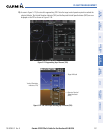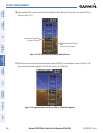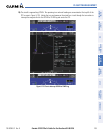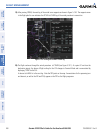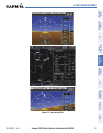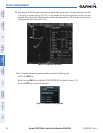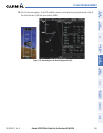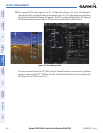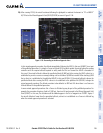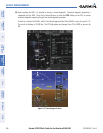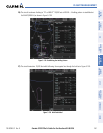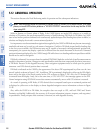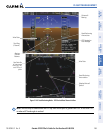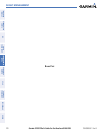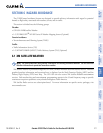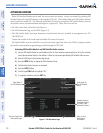
190-00595-01 Rev. B
Garmin G1000 Pilot’s Guide for the Beechcraft A36/G36
265
FLIGHT MANAGEMENT
SYSTEM
OVERVIEW
FLIGHT
INSTRUMENTS
EIS
AUDIO PANEL
& CNS
FLIGHT
MANAGEMENT
HAZARD
AVOIDANCE
AFCS
ADDITIONAL
FEATURES
APPENDICES INDEX
24) After crossing CEGIX, the aircraft continues following the glidepath to maintain the descent to “AT or ABOVE”
6,370 feet at the Missed Approach Point (MAP) (RW35R) as seen in Figure 5-136.
Figure 5-136 Descending to the Missed Approach Point
In this missed approach procedure, the altitude immediately following the MAP (in this case ‘6368ft’) is not part
of the published procedure. It is simply a Course to Altitude (CA) leg which guides the aircraft along the runway
centerline until the required altitude required to safely make the first turn toward the MAHP is exceeded. In
this case, if the aircraft altitude is below the specified altitude (6,368 feet) after crossing the MAP, a direct-to is
established to provide a course on runway heading until an altitude of 6,368 feet reached. After reaching 6,368
feet, a direct-to is established to the published MAHP (in this case MOGAL). If the aircraft altitude is above the
specified altitude after crossing the MAP, a direct-to is established to the published fix (MOGAL) to begin the
missed approach procedure. The altitude constraint value defaults to 400 feet AGL when there is no Course to
Altitude defined in the published procedure.
In some missed approach procedures this a Course to Altitude leg may be part of the published procedure. For
example, the procedure dictates a climb to 5,500 feet, then turn left and proceed to the Missed Approach Hold
Point (MAHP). In this case, The altitude would be labeled appear in the list of waypoints as ‘5500ft’. Again, if
the aircraft altitude is lower than the prescribed altitude, a direct-to is established on a Course to Altitude leg
when the missed approach procedure is activated.



